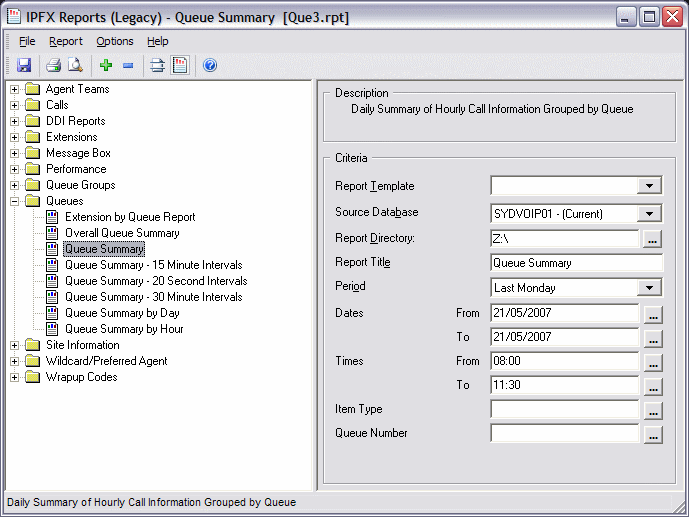Report Heading |
Definition |
Time Period |
Period set in Report Criteria (null periods may be unselected) |
Queue Number |
Number of the Queue |
Media Type |
Call, Email, Fax, TextChat or Callback |
Total Calls |
Total Calls delivered to the Queue |
Total Ans. Calls |
Sum of Answered Calls |
Total Abn. Calls |
Sum of Abandoned Calls |
Abn. Before Minimum |
Calls abandoned before minimum time limit set in Report Criteria |
Abn. After Minimum |
Calls abandoned after minimum time limit set in Report Criteria |
Other Calls |
Sum of Other Calls |
Talk Time Minimum |
Shortest period spent by a Call in Talk Time |
Talk Time Maximum |
Longest period spent by a Call in Talk Time |
Talk Time Average |
Average period spent by Calls in Talk Time |
Answered Queue Time Minimum |
Shortest period spent by an answered Call in Queue Time |
Answered Queue Time Maximum |
Longest period spent by an answered Call in Queue Time |
Answered Queue Time Average |
Average period spent by answered Calls in Queue Time |
Abandoned Queue Time Minimum |
Shortest period spent by an abandoned Call in Queue Time |
Abandoned Queue Time Maximum |
Longest period spent by an abandoned Call in Queue Time |
Abandoned Queue Time Average |
Average period spent by abandoned Calls in Queue Time |
Average Agents Logged In |
Mean number of Agents logged in over the period |
Calls Per Hour |
Rate of calls per hour over the period (e.g. one call in 15min = four Calls per hr) |
About the Queue Summary Report
This report gives a detailed summary of call flow over 15-, 30- or 60-minute segments (selected in the report criteria prompts; default is 30). The report provides a summary of events that can be used for comparisons and rostering.
Data shown: Total calls taken/answered/abandoned (before and after minimum abandon settings), maximum/minimum calls queued, average/maximum queue, talk/abandoned times, Service Level, Calls per hour, average number of agents logged in.
Tip: Select View summary in the report criteria prompt for a total for each queue that can be used for a company comparison. If you are managing multiple queues this is a good overview and you can use the detail report to drill down on information if required.
To create the Queue Summary Report:
- Select Queue Performance > Queue Summary:

- Enter the following report criteria as required:
Period
The span of days covered by the report (Today, Last Week etc.)
Alternatively, specify the exact date range using the Date criterion.
Dates
The date range you wish to cover in the report.
Times
Select hours of the day that you wish to cover in the report.
Queue Group
Narrows the scope of the report to a specific Queue Group.
Queue Number
Narrows the scope of the report to include only the selected Queue Number(s). Select the Queue Number(s) that you wish to include in the report from the drop-down menu or enter the Queue Number(s) with your keyboard.
To specify multiple Queues, separate each number with a comma (,). Do not include spaces in the list.
Item or Media Type
Narrow the scope of the report to include only the selected incoming queue media.
Depending on the IPFX Modules you have purchased you may be able to include Calls, E-mails, Faxes, Text Chats and Callbacks in the report.
Select from one of: CALL, EMAIL, FAX, TC, VM-CALLBACK.
Service Level Seconds
Defines your organisation's Service Level, in seconds. For example, if your service level requires calls to be answered within 20 seconds, enter 20.
Default is set to 20.
Include Blank Periods
To save space, a report normally omits displaying information about time periods in which there were no calls. Use this criteria to force the report to display lines for all time periods.
Yes display all periods, even those with no calls
No omit periods with no calls
Ignore (default, same as No)
Include Virtual Queues
Includes both standard and Virtual queues in the report.
View Summary
Determines the level of detail present in the report.
Yes Provides the report as a summary. Rows containing identical information are combined into a single line, with a Count column to show how many individual pieces of data each line represents.
No - Displays each piece of data on a separate line.
Ignore (Has the same effect as selecting No).
Format Time
Changes the way that time is displayed in the report:
Yes - Displays time in hh:mm:ss format.
No - Displays time in seconds.
Ignore - (Has the same effect as selecting Yes)